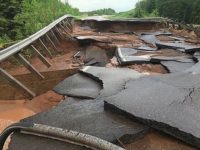The $19-million Construction and Skilled Trades Technology Center on one of Lone Star College’s six Houston campuses opened in late October, right in time to help meet the region’s soaring post-Hurricane Harvey rebuilding needs. The facility itself did not escape impact from the August storm, which sent 1 ft of water through its first floor, causing some equipment damage.
Originally intended to boost energy and industrial construction training, the 49,000-sq-ft center, funded from the state’s $485-million bond vote in 2014, has six classrooms and dedicated training labs for electrical technology, field-service technology, HVAC-R and pipefitting.
Lone Star’s larger construction-trades program has about 800 students enrolled, but quickly has added residential and commercial building programs that include framing, drywalling, roofing and sheet-metal work. “These skills are needed more now than ever, post-Harvey,” says Gerald Napoles, president of the college’s North Harris campus.
Students pursuing coursework in these areas can earn first- or second-level certificates or an associate degree in applied science. Three- to six-week courses were designed to be hands-on, allowing students to “get in and get out” into the workforce, says Michael Burns, Lone Star dean of career and applied technology.
The fast-track program is aligned with National Center for Construction Education and Research curriculum, he adds. “When the push has died down, they can come back and get a degree,” says Burns. Lone Star is the state’s largest higher education institution, with about 90,000 students and plans for a seventh Houston campus.
After Hurricane Irma hit Florida in September, two community colleges in the state already had fast-track programs in place to train workers, says Javier Rojas, construction program manager at Orlando’s Valencia College.
The school was asked to accelerate its Building Construction Specialist Certificate, but it wasn’t feasible for the 18-credit course, says Andrew Ray, campus program chair. The certificate can be used toward an associate degree in science. “We have a lot of veterans in the program,” Ray says. “They’re working … and can only go part-time. They chip away at the degree.”
Valencia has tool-stocked mobile units that take training directly to students who may not be able to commute to campus. “It’s designed to be express learning for people who have been looking for work or want to get into construction.
It gives them a good glimpse of what the work is like,” says Mike Steigerwald, Charlotte, N.C.-based senior workforce-training specialist at The Lane Construction Corp. Although Lane’s initial need in the Orlando area was to train workers for an interstate upgrade, “the program helps any community that participates,” particularly after a disaster, he says.
Florida State College, Jacksonville, has The Accelerator, a fast-track, non-credit training program that has helped in the post-Irma rebuild. “We work with local businesses to tailor training to fit needs in a shorter time frame,” says Cedrick Gibson, associate vice president of workforce development and entrepreneurship. The program has focused on welding, HVAC and electrical training, he says.






Post a comment to this article
Report Abusive Comment